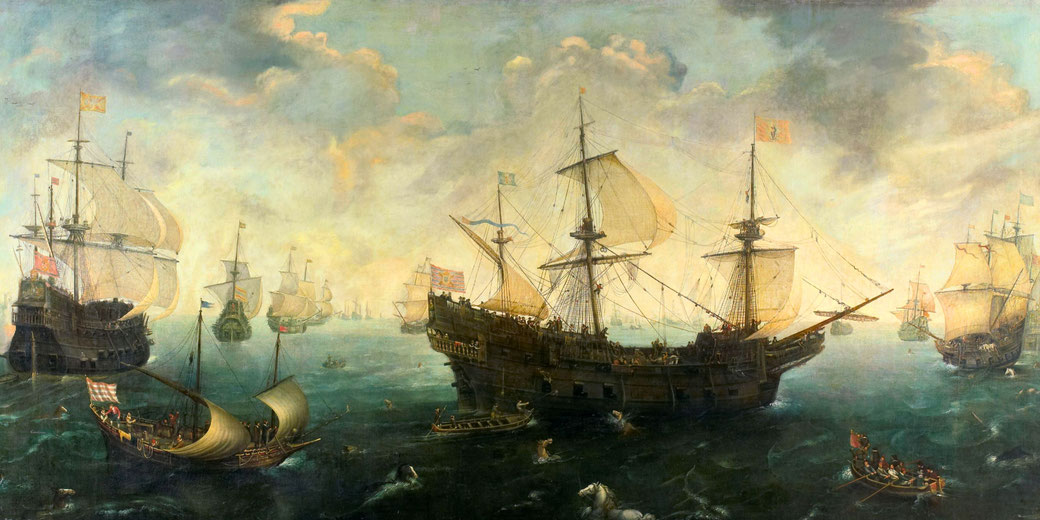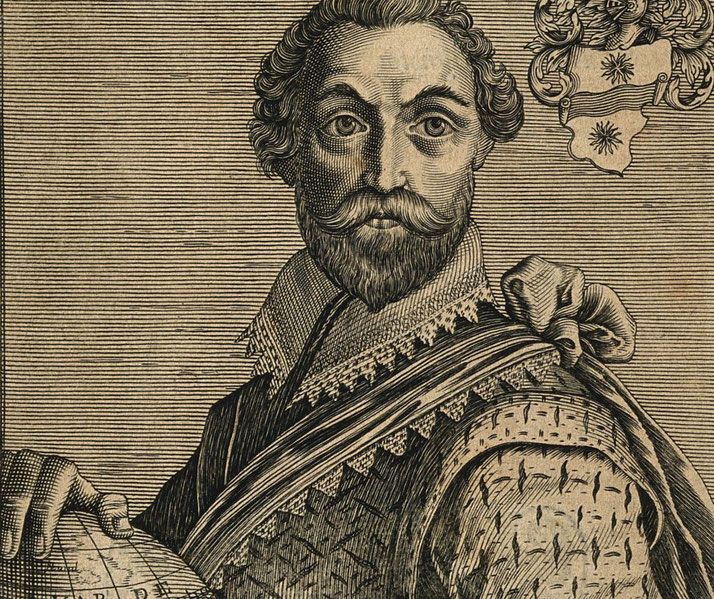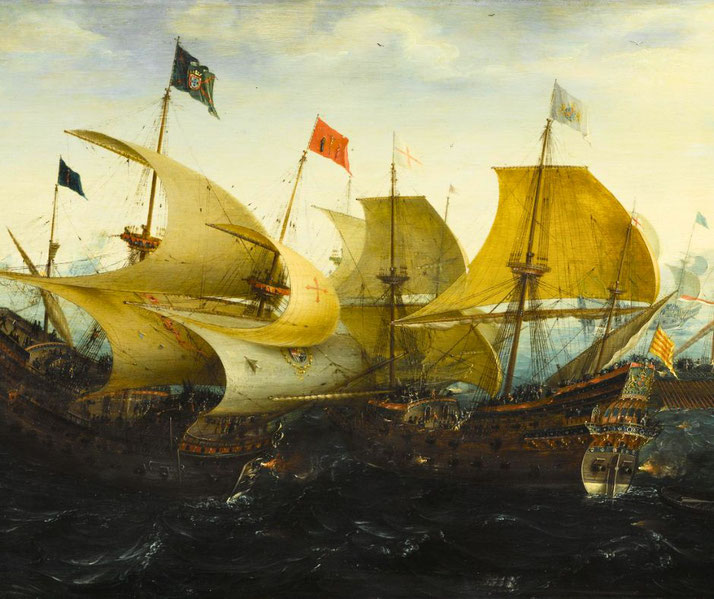How Elizabethan England repelled the 'invincible' Spanish Armada

In the summer of 1588, a record-breaking size fleet sailed from Spain with the intention of conquering England and removing Queen Elizabeth I from power.
King Philip II of Spain, a devout Catholic, regarded Elizabeth as a heretic whose rule threatened both his authority and the dominance of the Catholic Church.
The Spanish Armada contained 130 ships and an estimated 27,000 to 30,000 men, who carried the hope of restoring Catholicism to England while securing Spanish influence in northern Europe.
Its eventual defeat became one of the most celebrated events of Elizabeth’s reign.
Why did Spain want to invade England in 1588?
Religious conflict formed the main reason for Spain’s invasion plans. Philip II believed that Elizabeth’s excommunication by Pope Pius V in 1570 created a moral obligation for Catholic rulers to overthrow her as they were release from obedience from her rule.
Since England’s break from Rome under Henry VIII, Protestantism had taken a strong grip, and Philip viewed himself as the champion of the Catholic cause in Europe.
Political and economic rivalries strengthened Philip’s determination. English privateers such as Sir Francis Drake had been attacking Spanish ships returning from the Americas, seizing treasure that Philip considered his rightful property.
At the same time, Elizabeth’s support for Dutch rebels, who had been fighting against Spanish rule in the Netherlands, threatened Spain’s control over its territories.
When Drake raided the port of Cadiz in 1587 and destroyed vital supplies, Philip regarded the attack as a national insult and ordered preparations for a full-scale invasion.

Assembling the mighty Spanish Armada
Philip’s decision to invade England required the construction of a fleet that could transport soldiers across the Channel while also withstanding the English navy.
The Armada eventually consisted of 130 ships, which included heavily armed galleons, converted merchant vessels, and troop transports.
It carried more than 2,500 guns, as well as thousands of sailors and soldiers who expected to fight a major campaign in England.
The ships gathered at Lisbon, then Portugal’s most important Atlantic port, which Philip controlled after claiming the Portuguese crown in 1580.
Crews were assembled from across Spain and its territories. Philip entrusted command to the Duke of Medina Sidonia, whose noble status and loyalty outweighed his lack of naval experience.
Vast quantities of supplies and weapons were loaded on board, yet the fleet faced immediate problems as shortages of food and fresh water emerged even before departure.
The Armada’s success depended on a planned meeting with the Duke of Parma’s army in the Spanish Netherlands, which had been engaged in a long war against the Dutch rebels.

Philip's plan of attack
Philip developed a strategy that required perfect coordination between the fleet and Parma’s army.
The Armada would first sail up the English Channel, establishing control of the seas, before anchoring near Calais to await Parma’s troops.
Once the two forces met, Spanish soldiers would be ferried across to southern England and land near the Thames estuary.
After capturing London, Philip expected that Catholic uprisings would assist Spanish control of the country.
The plan relied on good weather and efficient communication, operating on the assumption that England’s navy would be too weak to oppose such a powerful fleet.
Philip placed great faith in divine help, believing that God would favour his mission to restore Catholicism in England.
Because the plan depended on perfect timing, any delays or unexpected problems risked complete failure.
How England rushed to prepare for the invasion
When intelligence confirmed the Armada’s preparations, Elizabeth’s government responded quickly to the threat of invasion.
The queen appointed Lord Charles Howard of Effingham as Lord High Admiral, supported by experienced seamen such as Sir Francis Drake and Sir John Hawkins, whose expertise in naval warfare gave England a vital advantage.
The English fleet included around 200 ships in total, though only about 55 to 65 of these took part in the main fighting.
Many of the engaged vessels were smaller and faster, carrying long-range guns that could fire more rapidly than the Spanish cannon.
England also organised land defenses to prepare for the possibility of a Spanish landing.
Local militias known as the Trained Bands gathered at key coastal points, while a chain of beacons was set up across the countryside to warn of the Armada’s approach.
Elizabeth’s speech at Tilbury, which she delivered on 9 August 1588 after the Armada had been driven north, famously declared that she had “the heart and stomach of a king.”
Her words boosted morale among her troops and reinforced her image as a determined ruler prepared to lead her people in defence of their realm.
The key moments of the Spanish Armada's journey
The Armada first departed from Lisbon on 28 May 1588 but returned for repairs after violent storms scattered the fleet.
It finally set out again in July and entered the English Channel soon after. The English navy, taking advantage of its more agile ships, harassed the Armada as it progressed along the Channel, engaging in battles near Plymouth and Portland where they inflicted damage while avoiding close combat.
The crucial moment occurred when the Armada anchored just east of Calais to await Parma’s army, who were not yet ready to board the ships.
The English sent fire ships into the harbour, causing panic among the Spanish crews.
Many captains cut their anchors to escape, which left the fleet scattered and vulnerable.
On 29 July in the English calendar, which corresponds to 8 August in the modern Gregorian calendar, the English launched a major attack at Gravelines.
The battle inflicted heavy losses and forced the Armada to retreat northwards.
The Spanish ships were short of supplies and unable to regroup, so attempted to sail around Scotland and Ireland in the hope of returning to Spain.

Spain's humiliation
The retreat turned into a disaster as storms battered the fleet in the North Sea and along the coasts of Scotland and Ireland.
Many ships ran aground or sank, and at least 15,000 sailors and soldiers died from drowning, starvation, or disease.
Of the 130 ships that had left Lisbon, fewer than 70 eventually returned to Spain.
The defeat shocked Europe, for Spain had been regarded as the strongest naval power of the age.
Philip did not admit defeat and launched a further two Armadas in 1596 and 1597. However, both failed due to storms and did not advance enough to threaten England.
The Armada’s failure diminished Spain’s standing and encouraged its Protestant enemies, who now viewed Spanish power as vulnerable.
How the English reacted to the victory
Celebrations swept through England as news of the Armada’s defeat spread. Bells rang in towns and villages, thanksgiving services were held in churches, and Elizabeth’s government promoted the victory as proof that God had favoured the Protestant cause.
The queen’s image as a resolute and divinely protected monarch strengthened her authority both at home and abroad.
The success encouraged England’s naval ambitions. English support for the Dutch rebels continued, and privateers increased their attacks on Spanish shipping.
Many contemporaries viewed the victory as a turning point that confirmed England’s growing strength at sea and its potential to challenge Spanish power on a global scale.
What were the real reasons for the Armada's defeat?
Several factors combined to ensure Spain’s failure. English ships, which were smaller and more manoeuvrable, carried long-range guns that enabled them to inflict damage without closing for boarding.
English commanders such as Drake and Hawkins used tactics that broke the Armada’s crescent formation and prevented the Spanish from regrouping.
Because Philip’s plan required close coordination with Parma’s army, slow communication and blockades by Dutch rebel ships made success impossible.
Severe storms completed Spain’s destruction. The weather scattered the fleet at Calais and later wrecked many ships as they sailed around Scotland and Ireland.
Shortages of food, inexperienced sailors, and a commander with limited naval expertise further weakened the Armada.
The defeat resulted from a combination of English preparation, superior tactics, and the failure of Philip’s overambitious plan, and it collapsed under the strain of poor planning and disastrous luck.
What do you need help with?
Download ready-to-use digital learning resources
Copyright © History Skills 2014-2025.
Contact via email
With the exception of links to external sites, some historical sources and extracts from specific publications, all content on this website is copyrighted by History Skills. This content may not be copied, republished or redistributed without written permission from the website creator. Please use the Contact page to obtain relevant permission.





